The Shoot Out: Smith & Wesson's M2.0 vs. Glock 26 (Who Wins?)
Let's compare.
But all generations of Glock 26 can hold at least 10 rounds in the mag, and all are comfortable to shoot and accurate (we’ll dig deeper on these later). The M&P9 M2.0 on the other hand, while it does feel better on the hand because of its longer 18-degree grip area, is bested by the Glock on ammo capacity as it can only hold a maximum of 8 rounds in the mag.
So as far as concealability and height-to-ammo capacity ratio, the Glock 26 Gen4 wins.
ACCURACY
There have been numerous accuracy tests done for both pistols online and either was shown to be plenty accurate for a CCW.
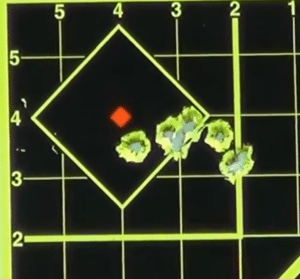
Both handguns are easily capable of very tight groups measuring around 2 inches or less from a distance of up to 10 yards which is about the farthest anyone would want to shoot in any self defense scenario.

Granted, these handguns differ in the type of barrel rifling they use and their rifling’s length of twist, but the differences are academic at best and can’t be used to determine how one is more accurate than the other.
So as far as accuracy, it’s a draw.
HANDLING
When trying to determine how well a handgun handles, I consider a few things:
- How easy it is to rack the slide (which depends on things like the recoil spring design and how well the slide is fitted to the frame)
- How well it aims (which depends on the installed factory sights and the gun’s natural tendency to point — a function of its point of balance and grip angle)
- How well it handles recoil (which depends on a handgun’s weight relative to the caliber it’s chambered for, the recoil spring’s poundage, and the ergonomics)
- How fast I can do accurate follow-up shots with it (which depends on how well it handles recoil and its trigger action)
This is an area where the S&W M&P9 M2.0 gets a narrow win over the Glock 26.
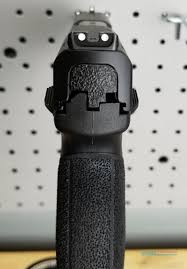 While both handguns have a tight slide-to-frame fit and both use dual recoil springs, the M&P9’s factory sights made of steel with its three-dot pattern simply outclasses the factory U-shaped rear and white-dot front sights of the Glock 26 made of plastic.
While both handguns have a tight slide-to-frame fit and both use dual recoil springs, the M&P9’s factory sights made of steel with its three-dot pattern simply outclasses the factory U-shaped rear and white-dot front sights of the Glock 26 made of plastic.
The M&P9 M2.0’s trigger has a short and quick travel with a tactile and audible short reset and has zero creep. You can really feel it when you’re pulling it as you hit that wall just before it cleanly breaks. This makes it better than the Glock 26’s mushy trigger, something all Glock owners complain about.
Also, the M&P9 M2.0 just feels better in the hand with all the subtle contours on its grip. In contrast, the Glock 26’s grip (and all Glock models’ grips for that matter) has a blocky feel to it which, even when installing any of the back straps included in the box, doesn’t feel anywhere near as good in the hand as the M&P M2.0’s grip.
So as far as handling, the M&P9 M2.0 subcompact wins.
DURABILITY
There’s no question that both handguns, with enough care, will hold up well against corrosion.
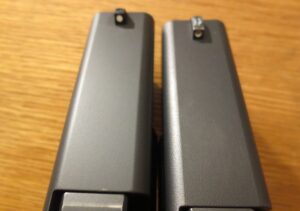 All Glock pistols have a highly corrosion-resistant finish called Melonite (or Tenifer depending on who you ask) which I did a bit of a research on in this previous round of our series of Handgun Showdown.
All Glock pistols have a highly corrosion-resistant finish called Melonite (or Tenifer depending on who you ask) which I did a bit of a research on in this previous round of our series of Handgun Showdown.
For their M&P line of handguns, Smith & Wesson use a similar proprietary method called Armornite.
Unfortunately, there isn’t too much info available online about this Armornite finish so I can’t tell whether it’s any better than Melonite. All I know is Smith & Wesson has the name trademarked. For this reason (and for another similar one, as we’ll get into later), I would have to give this win to the Glock 26.
EASE OF MAINTENANCE
As far as ease of maintenance, the Glock 26 (like all Glocks) can be field stripped in seconds without requiring the use of any kind of disassembly tool — only downside to this is the user has to pull the trigger to field strip the gun, which can be dangerous if there’s a round chambered in it and the user isn’t careful enough to check.
While I’ve done it more than a few times and I’m okay with pulling its trigger for disassembly, I’ve been handling guns for as long as I can remember so I can’t speak for everyone.
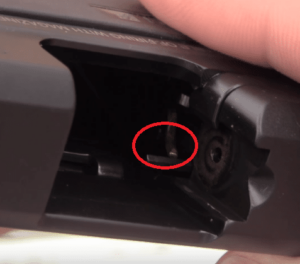 The S&W handgun on the other hand doesn’t require its trigger to be pulled for disassembly. But it does require some sort of tool like a cleaning rod or a pencil to reach the yellowish take down lever inside the gun.
The S&W handgun on the other hand doesn’t require its trigger to be pulled for disassembly. But it does require some sort of tool like a cleaning rod or a pencil to reach the yellowish take down lever inside the gun.
Being a 1911 purist I think anyone should be able to disassemble their handgun without any kind of tool so I would have to down-vote the M&P9 because of this — however when comparing it to the Glock 26 requiring its trigger to be pulled to field strip it, I see why some might prefer the former over the latter.
So for ease of maintenance, both having their share of pros and cons, there’s no winner.
CALIBER CONVERSIONS
Just looking at the chart from Lone Wolf below, we can see that the Glock 26 can be converted to shoot .40 S&W, .357 SIG and .45 GAP.
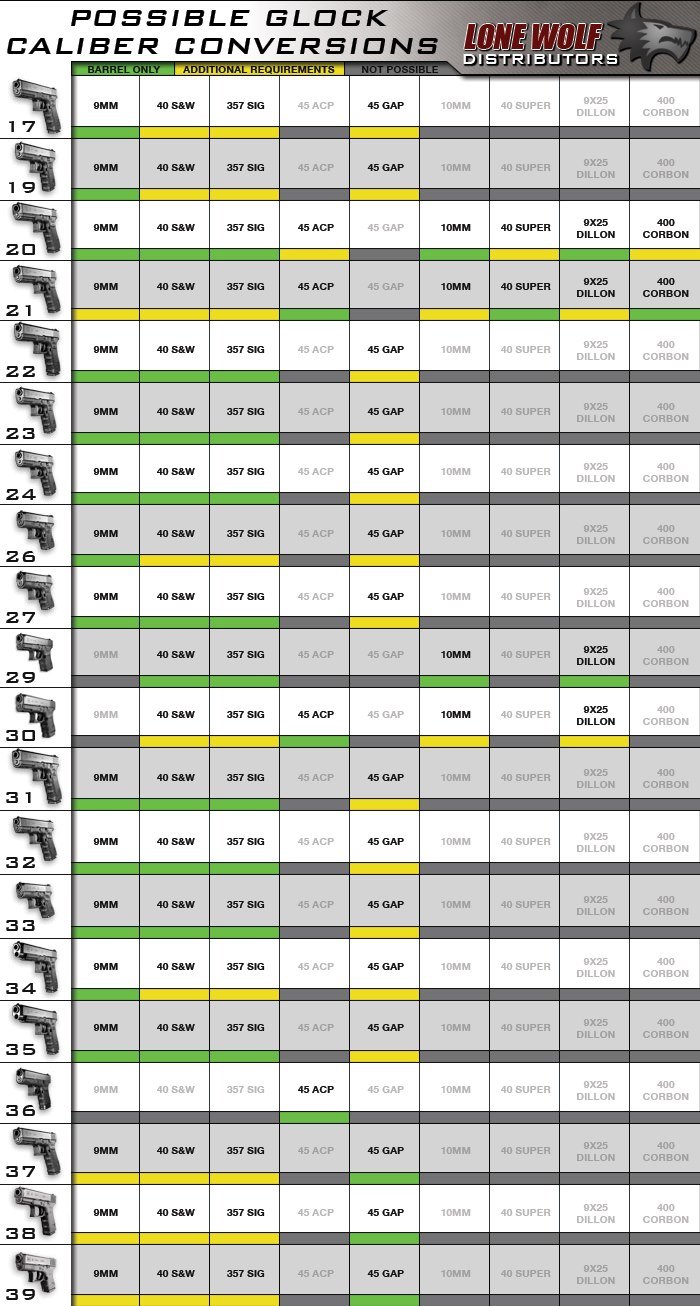
But there is no available info on caliber conversions for the M&P9 M.20 subcompact, unfortunately. And at the moment there are no third party barrel manufacturers that offer any kind of caliber conversion options for this handgun.
So without belaboring the point, when it comes to caliber conversions, the Glock 26 Gen4 being the more mature platform wins.
PRICING
The Glock 26 Gen4 retails for $549 on Glock’s website, while the M&P9 M2.0 subcompact retails for $479 on Smith & Wesson’s.
That’s a 14.61% difference in price which means if you’re a little short on $$$ but you want a reliable subcompact CCW you can defend yourself with, it’s a no brainer. You’ll have to go with the M&P9.
Now if you’re going to factor in the number of mags that come out of the box, the Glock 26 Gen4 comes with three ten-round mags while the M&P9 M2.0 only comes with a 7-round and an 8-round mag. That’s thirty rounds in the mag for the Glock compared to only fifteen rounds for the Smith, a 100% difference in ammo capacity.

That might not affect your decision making too much if you’re only looking for a CCW, but if you want a handgun that conceals well and also doubles as a plinking/recreational piece, that’s when you should really consider getting the Glock 26.
So as far as pricing, it’s a wash. I personally wouldn’t buy either handgun as I, again, just don’t like plastic guns — but if I really had to, I’d go with the Glock.
CUSTOMER SUPPORT
This is where I have a gripe about the M&P9 M2.0. Yesterday when I called Smith & Wesson’s customer support phone number and talked to the rep, I was told that they don’t have all the technical info I need. When I sounded like I was really going to be persistent about it, the rep said their engineering team would have all the info but no one shared it with their team.
 I was expecting they would at least have a cheat sheet somewhere or maybe he could talk to an SME on the production floor or something.
I was expecting they would at least have a cheat sheet somewhere or maybe he could talk to an SME on the production floor or something.
If I was a potential customer trying to get technical info on a certain company’s product to make a purchase decision and I’m told by that company’s representative (who’s supposed to know stuff about the product) that they don’t have the info I need, I would be quick to decide not to bother with them.
Like how is it possible that no one from Smith & Wesson, with all their marketing dollars being a major player in the firearms manufacturing industry in US, ever bothered to put the bore axis measurement of their M&P guns on their website? Or did they deem that little measurement too trivial to even bother with?
This also applies to the Armornite finish. Why is it that there isn’t a single source of info about it online? And why bother registering it as a trademark with the USPTO if it isn’t such a big deal? Or maybe some Smith & Wesson marketing exec thought it was just a name that sounded cool and decided to have it trademarked, providing no useful info to any potential customers curious about it?
I can’t help but think that if they’re this apathetic toward potential customers like myself, how much worse could it be if I already bought one of their products and I would need aftermarket support? You can go ahead and do a search on Google about it. While there are a few positive feedback on their customer service, the general consensus is it’s no good.

I’m disparaging Smith & Wesson — too many people don’t like them as a company already and it isn’t like Glock or any of their competitors are paying me anything to write an article against them. I may not like them but I don’t hate them either.

